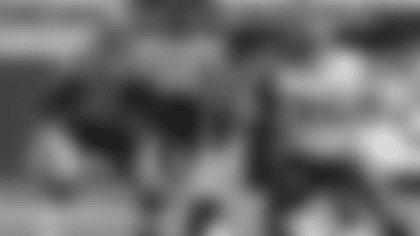Seahawks general manager John Schneider met with Seattle-area reporters Tuesday at the NFL Annual Meetings in Boca Raton, Florida, covering topics ranging from the state of the offensive line to who replaces Bruce Irvin to why Marshawn Lynch has not yet officially retired. Here are five things that stood out from Schneider's time with the media:
1. Garry Gilliam and Bradley Sowell could battle for the left tackle job, and more on the offensive line.
It's way too early to start guessing what Seattle's offensive line will look like when the season kicks off in September—the draft is still more than a month away, there are still free agent additions that could occur, and once camp begins, there are sure to be competitions at some positions. But while nothing is settled, and won't be for quite a while, Schneider did give an idea of where things stand at the moment after adding Bradley Sowell and J'Marcus Webb and losing Russell Okung and J.R. Sweezy in free agency.
"We've signed two guys in Sowell and Webb," Schneider said, via Bob Condotta of the Seattle Times. "They're unique signings, kind of prove-it signings. That's kind of the stage we're at right now. You always hate losing people in free agency—that's the worst part of our job, really—but you have to have a plan in place. We love Russell, we love Sweez and we wish them all the best, but we've got to keep moving forward."
Schneider said that, as the roster stands now, left tackle would, "Be a good battle between Gilliam and Sowell," with Webb playing right tackle and Mark Glowinski looking like the choice to replace Sweezy at right guard.
But again, nothing is settled yet. As Schneider has said in the past, the Seahawks will at least look into just about every option that's available via free agency and trade. More often than not, exploring an option doesn't mean a deal gets done, but the Seahawks aren't going to just sit back and call it good in late March.
"All throughout free agency, every position, we're going to keep tinkering and working our way through certain deals and see if we can be involved or if we can't," Schneider said, noting the salary cap limits what they can do. "Where we're at right now, we just have to be very responsible."
On Webb and Sowell, Schneider said, "Both very aggressive, confident individuals; guys who think they can take their career to another level. We really went with that same philosophy in free agency—not to the same level, but same philosophy—as we did with Cliff Avril and Michael Bennett. Shorter-term deals, come in and bust your butt, hopefully we'll be able to re-sign you, and if not you'll get to free agency quicker."
On Gilliam's potential to move to left tackle after starting at right tackle last year, Schneider said, "He's a heck of an athlete. He played there in college too. He's just such a good athlete, he could play really wherever he wanted. He can play tight end—you've seen him catch the ball. He's an extremely talented guy, as is Sowell. Sowell is very quick and athletic, and again, very, very confident in his abilities."
Ultimately, the Seahawks are in the same boat as nearly every team in the NFL when it comes to the offensive line.
"It's a concern for everybody, so you're constantly working at it," he said. "There's a reason we're converting defensive linemen to offensive linemen. There's really a shortage of talent at this point in the league. It's kind of a cyclical thing."
2. Replacing Bruce Irvin will likely be a group effort.
After beginning his career as a situational pass-rusher, Bruce Irvin developed into Seattle's strongside linebacker in the base defense, while maintaining a key role as a pass-rusher in the nickel defense. One reason Irvin, a former first-round pick, was able to play those two roles is that he is, as Schneider described it, "freaky athletic," so it probably won't be realistic to see one player come in and do everything Irvin did in Seattle's defense now that he is off to Oakland.
As is the case with the O-line, nothing is close to being settled yet, but one option Schneider outlines is for Frank Clark to take on some of Irvin's pass-rushing responsibilities, while Cassius Marsh and Mike Morgan could battle at strongside linebacker.
"When we drafted Frank—you have to prepare for the possibility of not having some players," Schneider said. "Obviously we wanted to have Bruce back and if the two of them were on the same team again, that would have been great, but to a certain extent you have to look towards the future."
3. Marshawn Lynch's trip to Egypt might be slowing the retirement process.
While Schneider made it clear at the NFL scouting combine that running back Marshawn Lynch is retired, news Lynch first announced via a Tweet during Super Bowl 50, the running back has not yet filed paperwork and the Seahawks have yet to place him on the reserve/retired list.
Schneider said there was nothing to that, noting that Lynch was out of the country recently with American Football Without Barriers Foundation, promoting the game in Egypt.
"We just haven't received his papers yet," Schneider said. "He's been out of the country riding camels and stuff."
4. At some point this offseason, the Seahawks will turn their focus to current players' contracts.
When talking about the players the Seahawks lost in free agency this year, Schneider noted that, "Really our free agency started last summer with Russell (Wilson) and Bobby Wagner." Schneider's point is that when it comes to constructing a roster and trying to retain talent, it's not just about waiting until players hit the open market, but rather being proactive when they can in order to keep their best players around. So while the Seahawks weren't able to retain Okung, Sweezy, Irvin and Brandon Mebane, one reason why they didn't have the cap room to do so was that they had already re-signed players like Wilson, Wagner, Earl Thomas, Richard Sherman, K.J Wright and Doug Baldwin, among others, to long term deals before they became free agents.
And now that the initial wave of free agency has passed, the Seahawks will begin to look at players still under contract who might be up for extensions this offseason.
"We have several guys who have one year left on their contracts, so that's always something we look at," Schneider said. "For planning purposes moving forward we have to know what's down the road. We have several key players who have one year left on their deals, so we'll try to address that at the appropriate time."
5. A lack of ego is a key element to Seattle's success in player acquisition and development.
When it comes to both free agency and the draft, one reason the Seahawks have had success under Schneider and head coach Pete Carroll is the relationship the scouting department and coaching staff have with each other. As Schneider noted, there are situations he has seen with other teams when a position coach might not like a player acquired to play for him, which can lead to some issues. In Seattle, Carroll and Schneider have tried to build an environment where coaches and the scouting department work together so both sides know what the other is looking for in a player.
"There's no ego," Schneider said. "Ego is the enemy, really. Being able to communicate in clear, concise fashion and make decisions as quickly as you possibly can. Knowing that first and foremost, we're looking out for what's best in the organization.
"We talk about no walls at our place. We include our coaches in the draft and in free agency, and they have buy-in."






